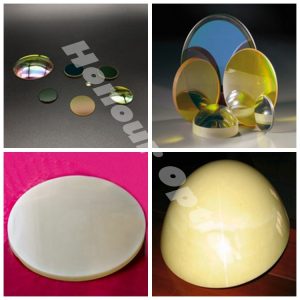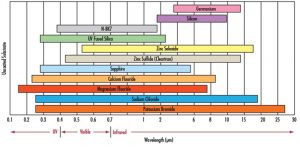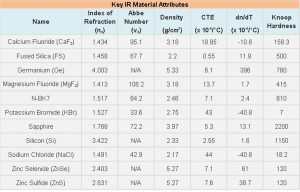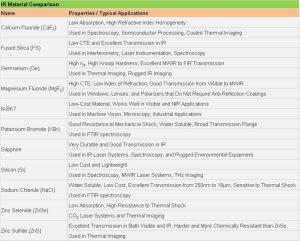

When choosing the correct IR material, the below listed simple points should be considered. Though the selection process is easier because there is a much smaller practical selection of materials for use in the infrared compared to the visible, these materials also tend to be more expensive due to fabrication and material costs.
Thermal Properties
Frequently, optical materials are placed in environments where they are subjected to varying temperatures. Additionally, a common concern with IR applications is their tendency to produce a large amount of heat. A material's index gradient and coefficient of thermal expansion should be evaluated to ensure the user is met with the desired performance. The coefficient of thermal expansion is the rate at which a material expands or contracts given a change in temperature. For example, germanium has a very high index gradient, possibly degrading optical performance if used in a thermally volatile setting.
Transmission
Different applications operate within different regions of the IR spectrum. Certain IR substrates perform better depending on the wavelength at hand. For example, if the system is meant to operate in the MWIR, germanium is a better choice than sapphire, which works well in the NIR.
Index of Refraction
IR materials vary in terms of the index of refraction far more than visible materials do, allowing for more variation in system design. Unlike visible materials that work well throughout the entire visible spectrum, IR materials are often limited to a small band within the IR spectrum, especially when anti-reflection coatings are applied.

Infrared Comparison
Although dozens of IR materials exist, only a handful is predominantly used within the optics, imaging, and photonics industries to manufacture off-the-shelf components. Calcium fluoride(CaF2), fused silica, Germanium(Ge), Magnesium fluoride(MgF2), N-BK7, potassium bromide(KBr), Sapphire, Silicon(Si), Sodium chloride(NaCl), Zinc Selenide(ZnSe) and Zinc Sulfide(ZnS) each have their own unique attributes that distinguish them from each other, in addition to making them suitable for specific applications. The following tables provide a comparison of some commonly used substrates.

